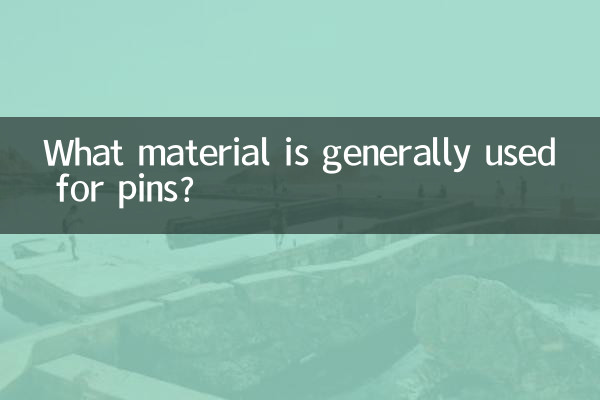What material is generally used for pins?
As an important component of mechanical connectors, pins are widely used in various mechanical equipment, automobiles, aerospace and other fields. The selection of its materials is directly related to the strength, wear resistance, corrosion resistance and service life of the pin. This article will combine the hot topics and hot content on the Internet in the past 10 days, introduce in detail the commonly used materials and characteristics of pins, and present them to you through structured data.
1. Common types of pin materials

The material selection of the pin needs to be determined according to the specific use environment and performance requirements. The following are several common pin materials and their characteristics:
| Material type | characteristic | Applicable scenarios |
|---|---|---|
| carbon steel | Low cost, high strength, easy to process | General mechanical equipment and general connectors |
| alloy steel | High strength, good wear resistance, fatigue resistance | Heavy load or high stress environment |
| Stainless steel | Corrosion-resistant, anti-oxidation, beautiful | Food machinery, chemical equipment, outdoor applications |
| copper alloy | Good electrical conductivity, corrosion resistance, self-lubricating | Electrical equipment, precision instruments |
| Titanium alloy | Lightweight, high strength, corrosion resistance | Aerospace, high-end medical equipment |
2. Basis for selection of pin material
Selecting the appropriate pin material requires comprehensive consideration of the following factors:
1.Mechanical properties: Including tensile strength, yield strength, hardness, etc., which need to meet the load requirements in the use environment.
2.Wear resistance: The pin may rub with other parts during movement, so it needs to have good wear resistance.
3.Corrosion resistance: In humid, acid-base or salt spray environments, corrosion-resistant materials, such as stainless steel or titanium alloy, need to be selected.
4.cost: The prices of different materials vary greatly, and a balance needs to be found between performance and cost.
5.Processing performance: The processability of materials directly affects production efficiency and yield.
3. The relationship between recent hot topics and pin materials
In the past 10 days, discussions about pin materials on the entire Internet have mainly focused on the following hot spots:
1.Lightweight demand for new energy vehicles: With the popularity of new energy vehicles, titanium alloy and aluminum alloy pins have attracted attention due to their lightweight properties.
2.Industry 4.0 and smart manufacturing: The application of high-precision alloy steel pins in automation equipment has become a hot topic.
3.Environmental protection and sustainable development: The use of recyclable materials such as stainless steel and copper alloys in pin manufacturing is widely discussed.
4. Future development trends of pin materials
Combined with current technological development and market demand, future development trends of pin materials may include:
1.Applications of high-performance composite materials: Such as carbon fiber reinforced composite materials, which can further improve the strength and lightweight level of the pin.
2.Improvements in surface treatment technology: Enhance the wear resistance and corrosion resistance of the pin through coating, spraying and other technologies.
3.Research and development of intelligent materials: For example, materials with self-healing function can extend the service life of the pin.
5. Summary
The material selection of the pin needs to be determined according to the specific application scenario and performance requirements. From carbon steel to titanium alloys, each material has its own unique advantages and applications. In the future, with the advancement of technology, pin materials will develop in the direction of high performance, lightweight and intelligence. I hope the structured data and analysis in this article can provide you with valuable reference.

check the details

check the details